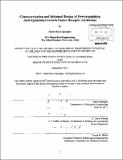Characterization and informed design of downregulating anti-epidermal growth factor receptor antibodies
Author(s)
Spangler, Jamie Berta
DownloadFull printable version (36.44Mb)
Other Contributors
Massachusetts Institute of Technology. Dept. of Biological Engineering.
Advisor
K. Dane Wittrup.
Terms of use
Metadata
Show full item recordAbstract
Due to its common dysregulation in epithelial-based cancers and the extensive characterization of its role in tumor growth, epidermal growth factor receptor (EGFR) has long been an attractive target for monoclonal antibodies. Intense research has culminated in the approval of two antibody-based drugs against EGFR for cancer treatment, with numerous others in clinical trials. However, therapeutic efficacy of these drugs has been disappointingly low due to autocrine signaling, receptor mutation, and transport limitations, necessitating novel antibody designs and mechanisms of action. Recently, it was reported that treatment with combinations of antibodies can induce receptor clustering, leading to synergistic receptor downregulation and anti-tumor activity. The aim of this thesis is to elucidate the details of this phenomenon and to exploit this mechanism to design more effective therapeutic antibodies targeting EGFR. We first illuminate several key aspects of combination antibody-induced clustering. By screening a panel of pairwise combinations, we show that the most potently downregulating pairs consist of two non-competitive antibodies that target EGFR extracellular domain 3. We further find the mechanism underlying downregulation to be consistent with recycling inhibition. Lastly, in contrast to the agonism associated with ligand-induced downregulation, we demonstrate that combination mAb-induced downregulation does not activate EGFR or its downstream effectors and it leads to synergistic reduction in migration and proliferation of cells that secrete autocrine ligand. To enhance antibody binding and induced receptor clustering, we design multispecific antibodybased constructs that engage up to four distinct epitopes on EGFR. We engineer two classes of constructs: one consisting of a full EGFR-specific antibody fused to the variable domain of a second anti-EGFR antibody and the other consisting of a full EGFR-specific antibody fused to one or more EGFR-targeted tenth type three domains of human fibronectin. Both classes of constructs induce robust receptor clustering and downregulation in the absence of signal activation. In vitro downregulation correlates well with in vivo inhibition of tumor growth in several mouse xenograft tumor models and mutational analysis demonstrates that the efficacy of our fusions is attributable to both signaling effects and antibody-dependent cell-mediated cytotoxicity. Our multi-epitopic strategy may be readily applied to other receptor systems to form the basis for a new category of antibody-based therapeutics.
Description
Thesis (Ph. D.)--Massachusetts Institute of Technology, Dept. of Biological Engineering, 2011. Cataloged from PDF version of thesis. Vita. Includes bibliographical references.
Date issued
2011Department
Massachusetts Institute of Technology. Department of Biological EngineeringPublisher
Massachusetts Institute of Technology
Keywords
Biological Engineering.